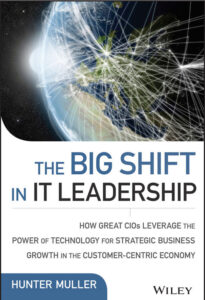The CIO’s Role in Stellar Customer Experience – Hunter Muller
Here are five ways CIOs can take a more strategic leadership role within their organizations generally and impact the customer experience specifically.
The role of the CIO has shifted dramatically in the past few years, from the traditional focus on “keeping the lights on” to playing a more strategic part in aligning IT with the business, as well as embracing trends like the consumerization of IT.
Yet in his new book The Big Shift in IT Leadership, author Hunter Muller “contends that many CIOs remain focused inward, only concerned with technology,” according to Anita Bruzzese on The Fast Track blog.
As Bruzzese writes, “The best CIOs, (Muller) says, know that results beat out technology. Having great technology doesn’t mean much if customers aren’t having a good user experience.”
Muller believes CIOs should not only contribute their expertise to efforts aimed at providing a great customer experience (for both internal and external “customers”), but to take a leadership role in this area.
He views IT leaders as uniquely positioned for this task, because CIOs “have total visibility across the organization,” and with that access, “have a golden opportunity to help develop innovative strategies and spur collaborations that will have a big impact on the organization’s overall success.”
Based on Muller’s insights, here are five ways in which CIOs can take a more strategic leadership role with their organizations in general and impact the customer experience specifically.
Use technology to improve the (internal and external) customer experience.
Though Muller believes “too many” CIOs are inwardly focused, he acknowledges that “a small portion of CIOs ‘see the writing on the wall,’ and know they need to ‘play the game at a higher level’ by shifting their focus outward to provide a stellar customer experience.”
Certainly, CIOs have a crucial role to play in optimizing the external customer experience, from offering easy online ecommerce and self-service tools to providing multiple paths for customer service interactions (social media, email, online chat, phone) to developing streamlined tools for customer support personnel.
But IT leaders often understand that great customer service starts on the inside. Employees who are not only treated well but also provided with easy-to-use tools for obtaining everything they need to do their jobs are more productive as well as more able and motivated to deliver a great experience to customers.
Implementing an enterprise request management (ERM) strategy—which combines an intuitive central portal for requesting any goods or services employees need at work with automated back-end fulfillment processes—is a highly effective and cost-saving approach to employee it provisioning.
Provide “total visibility” into internal service delivery performance.
Executives have many tools and metrics for measuring external service delivery performance: average call wait times, web analytics, customer satisfaction scores, customer retention rates, etc.. The CIO has a key role to play in supplying some of this data.
But what about performance with internal “customers”—the enterprise’s employees?
The technology behind ERM includes tools for measuring both quantitative (e.g., elapsed time to complete a specific fulfillment task) and qualitative (employee satisfaction with service accuracy and timeliness) service delivery metrics.
These tools enable IT leaders to measure and improve technical service delivery, by tracking SLA compliance at the task level and pinpointing sources of delay to take corrective action in real time.
Vitally though, since all types of enterprise shared services, from any function–HR, finance, facilities, training, etc.–can be presented and delivered through the ERM approach, all types of service delivery can be measured and improved.
Collaborate to fix problems quickly.
As technology plays an increasing role not just in all aspects of internal operations but in customer engagement as well, downtime becomes even more expensive. In Muller’s words, “IT really matters. It matters to the top line and to the bottom line. When IT has a bad day, the company has a bad day.”
Proactive monitoring helps minimize outages, but when systems go down anyway—due to a hardware failure, natural disasters, even data breaches—rapid and productive collaboration between internal experts, and often outside resources as well (consultants, vendors, contractors, etc.), is crucial for restoring operations as quickly as possible.
Businesses and government agencies need effective processes and collaboration tools in place to fix costly outages fast and respond rapidly to data security incidents.
Automate processes to protect information and systems.
Muller writes that “CIOs can no longer sidestep cybersecurity concerns and hand them over to security or risk officers. Senior leaders and a board of directors will expect the CIO to be prepared to handle any issues and resolve them quickly. Staff needs to be trained to be aware of the dangers, how to recognize a cyberattack and how to respond.”
Data breaches are costly, both in terms of their direct financial impact and loss of trust among customers and employees. With cyber attacks continuing to increase, it’s important to put response plans in place and take proactive steps to protect sensitive information.
Safeguarding an organization’s information assets requires action on several fronts, from physical access restrictions, employee training, and keeping security software updated to recognizing the role process automation can play in preventing data breaches.
For example, using automated processes to enforce periodic password updates, and “offboarding” departing employees to ensure their physical and systems access is properly and promptly terminated when they leave, helps keep information secure.
Hire talented people—with the skills needed for the future.
Muller advises CIOs to “surround yourself with great people,” make plans to win the war for IT talent, figure out how to motivate staff effectively, and assure mid-level managers are supporting staff development.
But creating a great customer experience requires more than just traditional technical skills. As CIOs focus more on customer experience, they’ll likely look at hiring for new skill sets, including design, social, and data translation skills.
Muller concludes, “Today’s businesses focus on delighting customers, because that is how you make the most money.” His finding suggest that savvy CIOs will shift their efforts toward optimizing the customer experience. And the most forward-thinking understand that great customer service starts with an excellent employee experience.
Next Steps
- Download the white paper The Technology Behind Enterprise Request Management.
- Check out the Enterprise Request Management group on LinkedIn.
- Contact Kinetic Data to discuss your customer experience challenges.




